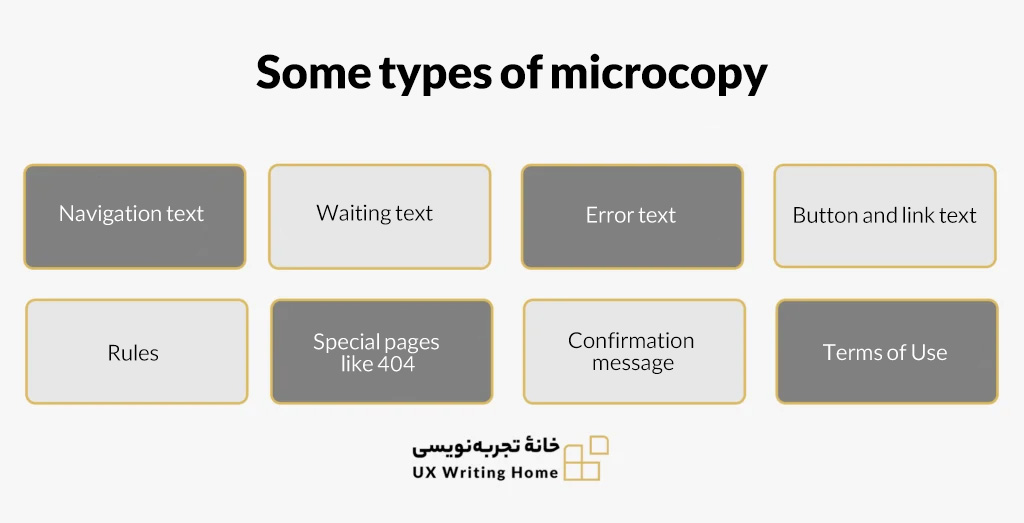What is microcopy?

Exactly what is a microcopy? Think about visiting an unfamiliar place.
A journey that begins with a guide is accompanied by richer achievements. When we decide to enjoy the beauties of Morocco or Greece without guidance, we are forced to discover everything on our own.
We have to buy ice cream more expensively, pay more for taxi fares, get incomplete information about tourist attractions. And after a lot of twists and turns, we just realize how wrong we are.
What is the microcopy? The microcopy is our travel guide to the product.
What is UX Microcopy?
In every digital product (types of applications and websites) there are words and sentences to guide or invite the user. We call these writings microcopies.
Language, as the most prominent human achievement, has conveyed human feelings, needs, commands, and desires for millions of years.
Who is the product created for? Undoubtedly for humans. It is natural that any product, whether digital or tangible, needs subtleties to communicate with the user to complete what we call the user experience.
What are the uses of microcopy?
Microcopies deal directly with the user and are generally written to guide the user. This is the main goal: to guide the user to make the best use of the digital or tangible product.
Microcopies tell the user in different situations:
- Where and under what conditions is it now?
- What are its options (show options)
- What can he do?
- What it can not do (reveal restrictions)
- It solves a concern
- Reminds of a subject
- Prevents a mistake
- Smoothes the user path
Types of microcopies
What are the types of microcopies? The image below gives us a good view:

Details to consider before writing
Knowing the purpose of writing a microcopy helps us to consider these details before writing them:
- What is a product and what is its use?
- Who is the audience? (Knowledge level, skills, attitude, personality, etc.)
- At what stage is the product design? (At what stage do UX burners join the design team?)
- What are the visual limitations for UX Copy?
- What are the requirements or restrictions of the business?
- What is the user journey map to reach that stage?
Features of functional microcopy
What is the standard for a microcopy to work properly? When can we say that a microcopy did its job properly?
- If, while efficient and guiding, the sentence is not engraved in the user’s mind and does not create friction for him. It seems like it has never been read at all.
- If it is clear, explicit, simple, and comprehensive.
- If he has stated the necessary things.
- If it is the size. (As short as possible, but not so obscure.)
- If removing ambiguity in different product situations.
- If it meets user expectations.
- If honest with the user.
Where are the red lines in microcopy design?
Be careful and know what the limits of microcopy creation are. Remember:
- Designing and writing a microcopy is different from artistic creativity. Here, too, creativity and intuition are important, but not for what we call “art.” Our main goal is to solve problems and guide different types of users with different skill and knowledge levels, not to create a literary work of art.
- It is very important to observe integrity. We can not use “I understand” at one point to close a Module or window, “OK” at another, and “Close” at another.
- Readability, spelling, grammar, and writing principles are important.
- Do not forget to rely on the user’s mental presuppositions. User preferences are always a priority. Do not play with user habits.
Change microcopy, change click rate
Consider the changing label on the button below by Nicolás J. Engler. After a user clicks on it, the label changes from “submit” to “sending.” This small yet thoughtful change lets the user know the system is working in the background to process whatever the user submitted. Once the process is complete, the label changes again from “sending” to “done.” A fantastic example of how microcopy can inform, delight, and guide the user.
MARIA DE LA RIVA
And finally: microcopy design is one of the tasks of a UX writer.
How to design microcopies?
Great writers can teach us a lot, as I have always said. User experience content designers can learn a lot from Hemingway, for example.
You might like to consider this example from Mark Twain: (I admire both of these authors a lot.)
Mark Twain once wrote, “Writing is easy. All you have to do is cross out the wrong words.” Anyone who’s ever agonized over the right words can appreciate the irony.
Words, in any context, hold weight. In our digital products, they make the difference between an exceptional user experience and a lackluster one. Microcopy ought to provide users with clarity and confidence, “If I do X, then Y will happen.”
Beyond that, microcopy is an opportunity for businesses to engage users by coupling aspects of their brand voice with an interface’s functionality.
It might not be easy to break from the templatized words we’re all familiar with (Click Here, Sign Up, Submit), but it’s well worth the effort to uncover microcopy details that delight users and boost conversion.
Milan Jovanovic – TopTal


